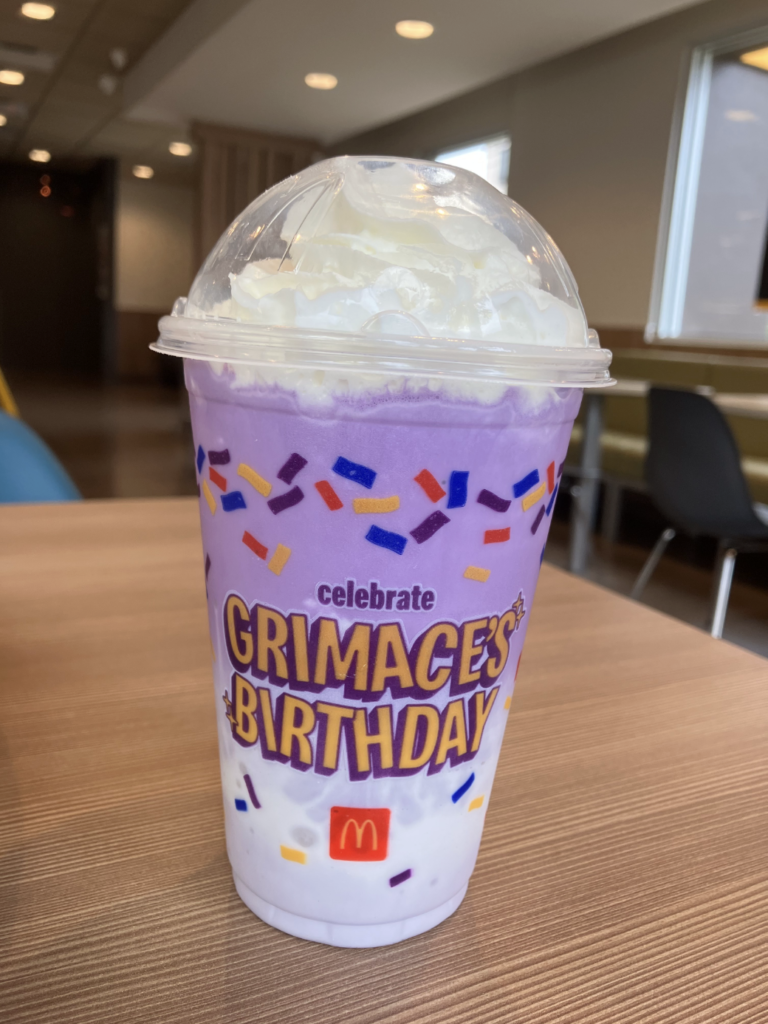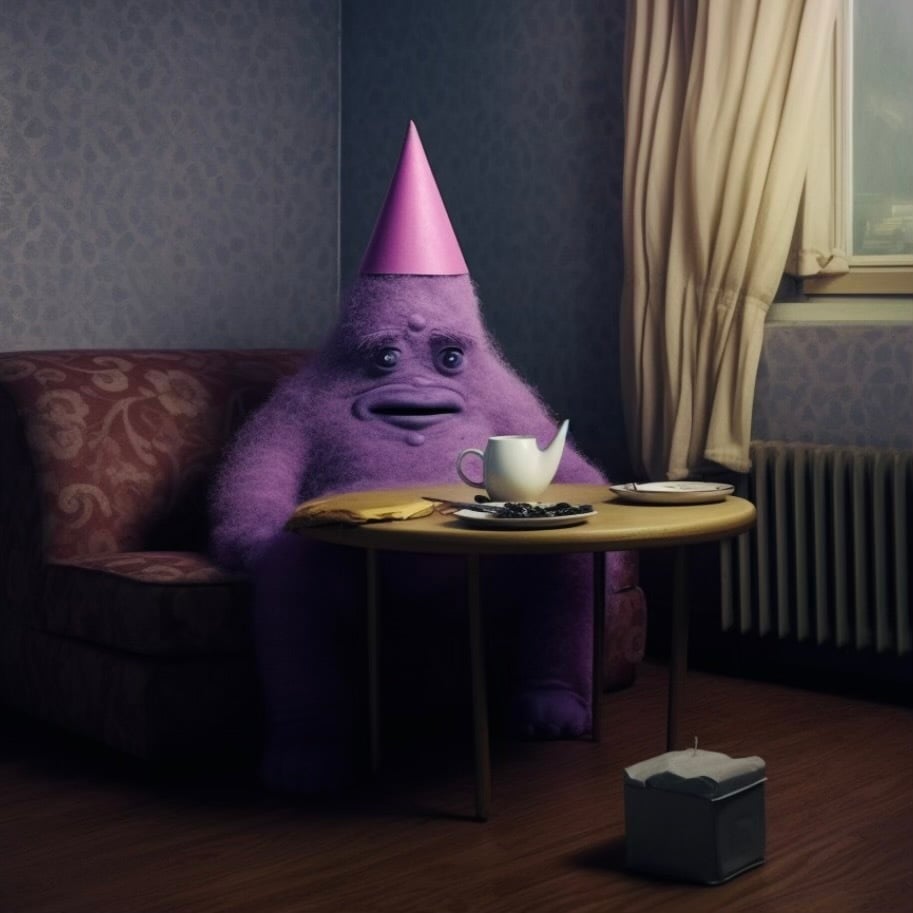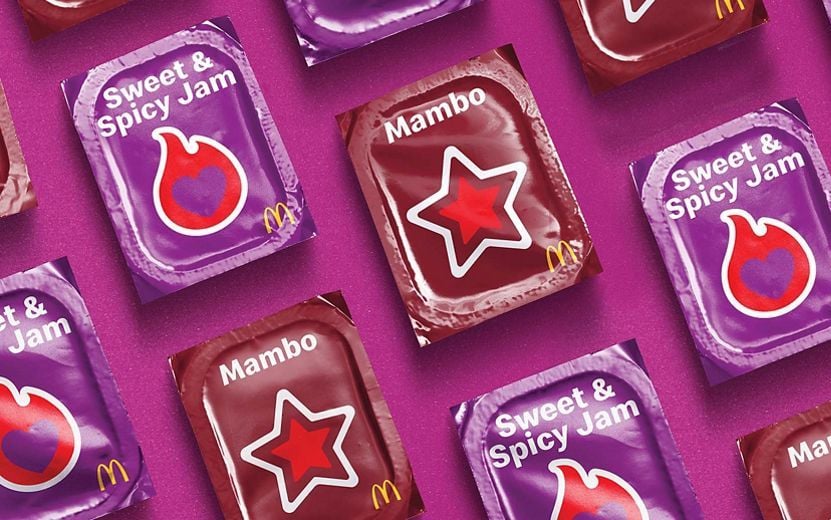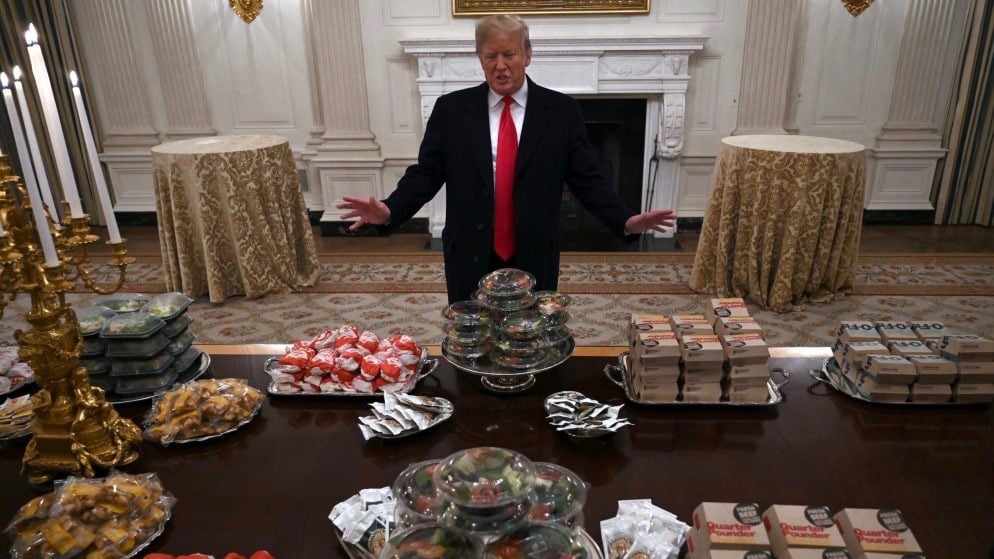It’s the afternoon of June 12, and the weather is not ideal for the debut of the Grimace milkshake: rainstorms threaten, the air does not swelter, and it’s a Monday—not a day of indulgence for most. Nonetheless, Grimace turns 52 only once, so here I am at the Tenleytown McDonald’s with my “Grimace Birthday Meal.” This includes ten McNuggets, fries, and a purple milkshake with a spray of whipped cream, served in a plastic “Grimace’s birthday” cup with confetti printed around the side.
To be candid, I am not a regular at McDonald’s, but I’m here because of a friend. She recently sent me an old Food & Wine article that raised a provocative question: What, exactly, is Grimace? Yes, he’s a blob-shaped cartoon marketing character, but what is he? An animal? A vegetable? A mineral? Granted I’d not thought about it terribly hard, but I always imagined him as a prune.
The answer turns out to be weirder: In 1971, Grimace was introduced as an evil monster with four arms, each of which stole milkshakes. But that design scared children, so McDonald’s chopped off two of those arms and reintroduced him as a kindly, bumbling purple critter, a beloved member of the McDonaldland gang. Later, Grimace was revealed to be not an individual, but a species—as in, there’s a whole family of Grimaces who live on Grimace Island.
But as to what these Grimaces are, nobody seems quite clear. McDonald’s personnel have variously claimed that a Grimace is a monster, the “embodiment of a milkshake,” a “personification of the child in everyone,” and an “enormous taste bud.” This origin story is so weird and chaotic that I’ve chosen to drop $15 on the Grimace Birthday Meal, which I don’t even expect to like.
Before I describe the meal, let me tell you about the scene. This is the Tenleytown McDonald’s at 3:30 pm, also known as “DCPS-is-out o’clock.” On cue, the teens swarm, and I start popping over to their tables to ask if they’re celebrating Grimace’s birthday. “Who?” asks a girl from Alice Deal Middle School. “What is that?” says her friend, looking perplexed. “Like the facial expression?” asks a boy from Jackson-Reed High School. A common theme emerges during my chats with these teens: They hardly know Grimace at all.
But, how could this possibly be? Well, according to the authoritative source on Grimace—the McDonald’s fandom wiki—Grimace disappeared from public life in 2012 after dancing at a Phillies game, then re-emerged in 2020 at the Macy’s Thanksgiving Day Parade. This means that, for eight of Gen Z’s formative years, Grimace was missing. The teens don’t care about him. He’s not even part of their world.
Nonetheless, these are polite and cooperative people who want to answer my questions, so they all search for pictures on their phones. Asked what they think Grimace is, they say that he’s “like a purple cookie monster,” an “alcoholic cookie monster,” a “sad little monster,” a “muppet,” a “mascot of the company,” a “big purple ball of fluff or something,” an “oversized person,” and “some kind of animal.” “He’s built like a pear,” one girl observes. “They could have maybe added more color,” her friend critiques.
These teens are game to describe Grimace, but none of them seem particularly intrigued. Perhaps that’s why, as they saunter around McDonald’s, they carry blue shakes and brown shakes and red shakes, but not one of them is sipping a purple Grimace shake—not even on the day of his birth.
I, at least, have ordered a Grimace shake, so let me tell you how it tastes: It’s like sipping purple satin, like someone bottled a fluffy, violet cloud—pillowy, thick, and glossy—an incredibly competent milkshake, so absurdly creamy that the flavor merely wafts atop the fat.

But that flavor, I guess, is where I quibble—hints of grape, notes of generic berry, like someone blended a bag of Welch’s gummies with butter and milk. It’s totally pleasant; McDonald’s has made a good shake. It’s just not how a Grimace should taste.
This question—of how a Grimace should taste—has become a preoccupation of mine, so I pose it to the teens at McDonald’s. Some of their answers are delightful: “Kind of soggy, like cotton candy,” one girl says. “Like everything on the menu smacked together,” replies a boy. “Something they’d give adults at the bar,” adds his friend. Given that Grimace is arguably a monster, one girl believes that his shake should have “big, chaotic flavors bursting in your mouth.”
I think these kids are correct; the grape-berry Grimace shake goes, in my opinion, against the spirit of Grimace. It’s so literal, so predictable: Grimace is purple, and therefore he tastes like a grape. This is the worst version of Grimace, a bland McDonaldland character hawking Happy Meals on TV. I didn’t care about that Grimace as a child, and I had fully dismissed him as an adult—that is, until I encountered the poignant heart of that Food & Wine article: that McDonald’s doesn’t even know what Grimace is.
Over the years, it seems, the suits of McDonaldland tried many things to make him work—they dismembered and repackaged him, created contradictory backstories, and floated various explanations of what he might be. But it’s almost like Grimace exists independently of McDonald’s; after decades of trying, the marketing team still can’t get a handle on him. He’s an unknown life form, named for an expression of pain or repulsion. He flies in the face of glib corporate positivity. Yet somehow, he’s still here.
Maybe Grimace began as a children’s marketing gimmick, but he’s surely transcended it now. Grimace is a bizarre and uncategorizable entity with no clear referent in nature. Maybe we love him for that—for his refusal to be understood.
That, in sum, is the essence of my objection to the Grimace shake: There’s not any mystery or surprise. It’s a good milkshake, and nothing more. It’s not like Grimace at all.
Leaving Grimace’s birthday, I feel a little sad, and at first, I can’t figure out why. I drank a good milkshake and met some fun teens—what else could I possibly expect?
In trying to plumb my melancholy, I type a thousand words of garbage into my phone, 700 of which—I am sorry to say—are about Freud. He wrote that even the most thoroughly interpreted dream contains a “navel,” an inexplicable dream fragment that connects our conscious mind to the unknown. “Grimace is the navel of the dream of McDonaldland,” I write. It feels ridiculous even to type.
But while musing about dream navels, I stumble onto something that feels true. “I went to the Tenleytown McDonald’s not to solve a mystery, but to create one,” is a sentence that appears in my notes. Here’s what that means: I didn’t want to learn what a Grimace is, or what a Grimace tastes like. I wanted to share my delight that it’s impossible to know. Nobody at McDonald’s seemed to get it, though, which has made me feel kind of alone.
Maybe it’s inevitable; “Grimace’s birthday” is just a marketing campaign, after all. An ad executive tells AdAge that adults who are “faced with an uncertain future” and living in “turbulent times” can go to McDonald’s to “connect with the past”—Grimace’s birthday, he implies, is meant to bring people like me great comfort. That in itself is alienating; the more distant I feel from my childhood, the better I assume things have gone.
At this point, I’m ready to close the book on Grimace’s birthday—I’ve celebrated, it was fine, and it’s done. But when I get home, I encounter my teenage son, who is miffed that I spent the afternoon interviewing teens that aren’t him. Dutifully, I ask him about Grimace. “The big chunky boi?” he says, knowing exactly who I mean.
At first, when I ask what Grimace is, my son seems completely unperturbed. “Quite frankly, he looks like an eight year old’s drawing of obese Barney,” he replies. Then I ask what a Grimace tastes like, and things get tense. “Who asks that??” he bellows, looking vexed.
But it’s then that something changes—his face slackens then furrows—and I can see it descending, the full weight of the mystery. I’ve asked a question he can’t really answer, and he feels delighted but also disturbed. “In the long run—” he says, and then stops himself. “I don’t know…is he supposed to be an eggplant or something?” He pauses, then grins, then adds with wild urgency, “Actually, what is Grimace? What is he even doing on the team?”
This is the moment I’ve been waiting for—the revelation that something extraordinary has been hiding in plain sight all along. It unlocks something for both of us, and we chatter at length about McDonaldland, a conversation that’s freewheeling, occasionally vulgar, and exuberantly weird. I don’t record it. I can’t tell you what was said. But for thirty minutes, on the Monday evening of Grimace’s 52nd birthday, we celebrate in the spirit of Grimace. It doesn’t even require the shake.















